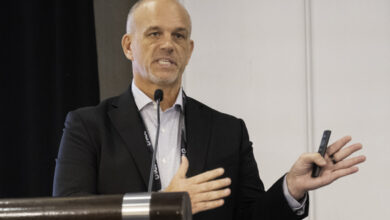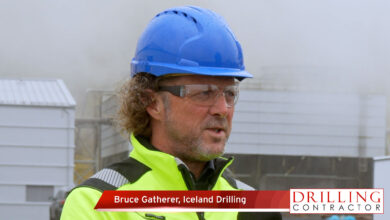Focus on HSE culture delivers lasting results
KOC group streamlines safety initiatives, focuses on ‘winning hearts’ to support HSE
By Mohammed J. Al-Saeedi, Nayef Al-Anezi, Subba rao Palagummi, Sridhar Gopalan, Abdul Latheef, Jignesh Thakkar, Kieran D’Silva, Kuwait Oil Company Deep Drilling Group
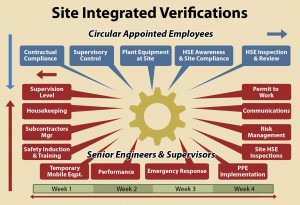
Kuwait Oil Company’s (KOC) Deep Drilling Group, established in late 2008, has doubled its rig fleet since starting out with six 3,000-hp HPHT-type rigs. Considering such rapid growth, there was a need to align and standardize the systems and provide a link between office and field to focus on HSE to support KOC HSE management system implementation across the group.
Time was short, and expectations were high in terms of HSE; a merger had to take place with respect to new people, new rigs and new initiatives by using the available resources. This was to ensure all teams were in the same line of thinking on HSE.
Accordingly, HSE functions in the group have been integrated seamlessly to achieve the objective of exceeding KOC senior management expectations. This could happen only by securing buy-in from everyone.
Deep Drilling Group moved forward with an aim to create the HSE culture within the group by instilling employees with a belief that HSE is everyone’s responsibility. The goal was to create a system that works by itself rather than depending on individuals. To ensure this happens, the focus has been to standardize and streamline various HSE aspects and initiatives.

HSE initiatives that delivered results included:
• Standardization of roles and responsibilities of HSE professionals;
• Standardization of incident reporting (both office and field);
• Standardization of “HSE Moment”;
• Standardization of pre-spud checklist;
• Standardization of monthly rig HSE inspection checklist;
• Standardization of camp hygiene inspection checklist;
• Standardization of guidelines for acceptance of new well-site construction;
• SIMOPS (simultaneous operations task planning);
• Enhanced interactions through weekly HSE meetings; and
• Monthly HSE video clip show for all staff to enhance HSE awareness.

Standardization of roles & responsibilities of HSE staff
This initiative defines the roles and responsibilities of HSE staff working both in the office and in the field to ensure each individual knows what he needs to do and his areas of responsibility. This has been reviewed by the team leaders and manager.
Standardization of incident reporting
Considering the serious commitment and focus on all incidents occurring across KOC by senior management, Deep Drilling Group management made a commitment to ensure all incidents, including near-misses, are reported immediately upon occurrence, with full transparency.
Any incident or near-miss that occurs on a particular rig will be communicated to the concerned personnel 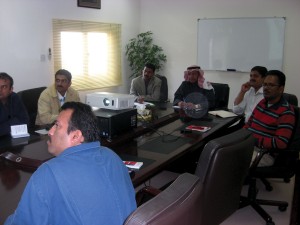 in a timely manner (Figure 4).
in a timely manner (Figure 4).
Weekly incident summary
Deep Drilling Group initiated sharing lessons learned through a weekly summary of all incidents occurring in the group’s rigs with causes and actions. This is sent on a weekly basis to all rigs and to the directorate and corporate HSE teams.
Standardization of rig HSE inspection checklist
HSE inspections are being carried out on all rigs in the group with a checklist that has been standardized for all of Deep Drilling’s rigs to ensure uniformity. This checklist was developed through brainstorming sessions with the field HSE staff and further reviewed by the group’s team leaders and manager.
It has become routine practice to carry out inspections on the rigs with the same checklist, and concerns are addressed and highlighted to the respective team leaders.
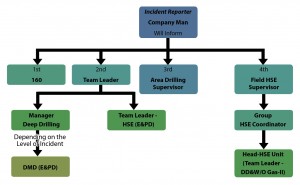
Standardization of camp hygiene inspection checklist
The rig-site camp should be treated equally importantly, and inspections are carried out by field HSE staff. To ensure uniformity across the group, a brainstorming session was conducted with all HSE staff in the presence of the Head–HSE Unit (Team Leader-DD&W/O Gas-II) to standardize the checklist, with input provided by personnel with experience from various areas. This checklist is being utilized on all Deep Drilling rigs.
Enhanced interaction through weekly meetings
Weekly meetings are held to ensure effective coordination among the group’s HSE staff. The meetings are chaired by a team leader in charge of the HSE unit, and there is participation by field and office-based HSE staff. To date, 60 meetings have been conducted, and they have helped to resolve numerous HSE issues. In turn, this has helped in sharing the lessons learned across various rigs in drilling operations and allowed for brainstorming on key issues.
Effective coordination with directorate and corporate teams
Due to the expansion of HSE activities in the overall Exploration & Production Development (E&PD) Directorate, it was necessary to cascade the HSE communication on all KOC HSE initiatives through effective coordination with the E&PD HSE team and KOC corporate HSE team. The HSE unit and enhanced HSE resources in the field have helped greatly in this communication process.
Standardization of HSE moment
HSE Moment is at the top of the agenda for all rig safety meetings, and it has been standardized to ensure uniformity across rigs. The HSE Moment is discussed during the weekly HSE unit meeting in the office and further circulated to all rigs to share in rig weekly safety meetings. This has helped in reviewing certain procedures.

Implementation of new initiatives
With approval from teams and the group manager, the new initiatives were implemented for crews through several ways.
Leadership HSE visits
HSE visits by E&PD Directorate leadership represent one of the most important activities that leaders can do to demonstrate their accountability for HSE and positively influence the work force.
Although this visit can cover the entire HSE area, main focus has been given to the theme assigned in the guidelines, i.e., working at heights. This also involves safety observation and conversations to commend good performance in effort to motivate workers to repeat good performance and to demonstrate that there is “duty of care” from the Deep Drilling Group management in terms of HSE.
Criteria involved in the leadership visits are:
• Follow leadership visit guidelines;
• Focus on the theme of the month;
• Verify contract HSE clause; and
• Review applicable HSE procedures pertinent to the theme.
The methodology of the visits include:
• Discussion with staff and crew on HSE issues;
• Walk through the rig site; and
• Verification of HSE documentation.
The aim and objective of the site-verification visits are:
• To prevent accidents and verify the level of safety assurance at the work site;
• To demonstrate the visible commitment toward safety of workers and integrity of assets at site;
• To improve HSE performance of contractual activities being carried out at the work site;
• To ensure inspection and rectification by accountable parties for safety and integrity at the work site; and
• To enhance communication among contractors, subcontractors and the controlling teams.
Participation in rig safety meetings
To avoid confusion in the perceptions of various individuals ranging from roustabout to the rig toolpusher, team leaders and managers participate in rig safety meetings to understand the HSE issues of each rig, to value good suggestions from everyone and make on-the-spot decisions to improve HSE performance.
HSE issues top of the agenda
Daily, weekly and bimonthly operational meetings have HSE issues at the top of the agenda, which helps to integrate operations and HSE.
Success behind the HSE culture
• Keep the organization focused by discussing the case studies of the group’s own area first;
• Perform gap analysis and move forward;
• One-on-one coaching and feedback and value crew suggestions on safety;
• Serious focus on behavioral change through “walk the talk” with a personal touch;
• Succeed in driving crew behavior from “HSE is important if I am observed” to “HSE is a part of the way I work”;
• Believe that implementation of HSE initiatives have a direct link to culture; and
• Believe that HSE culture delivers motivated and more satisfied employees who will align themselves with company goals.
The focus to bring in behavioral change was achieved through:
• Meeting and greeting people at the rig site irrespective of their position;
• Talking with people rather than talking to people in order to understand personal issues that may be the root causes of some incidents;
• Have safety observations and conversations to get to know the safety issues and provide solutions to create confidence among the crew; and
• Team leaders join lunch with junior crews to demonstrate “duty of care.”
Conclusion
Deep Drilling is striving toward reinforcing a culture that will lead to compliance with HSE requirements as part of HSE culture and not as an obligation.
We believe that winning hearts is the only way to sustain HSE culture and achieve incident- and injury-free operations.
This article is based on a presentation at the 2011 IADC Critical Issues Asia Pacific Conference & Exhibition, 23-24 November, Kuala Lumpur.



